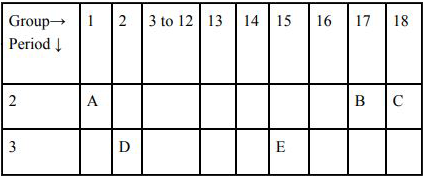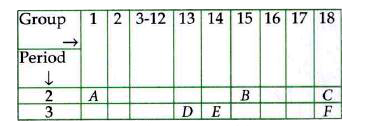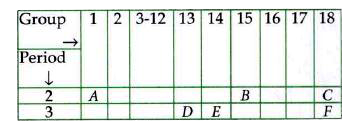The following table shows the position of six elements A, B, C, D, E and F in the periodic table.

Out of D and E, which one has a bigger atomic radius and why?
D , because the atomic size decreases along a period from left to right.
Topper's Solved these Questions
- PERIODIC CLASSIFICATION OF ELEMENTS BOOK - CHETAN PUBLICATIONCHAPTER - PERIODIC CLASSIFICATION OF ELEMENTS EXERCISE - Explain the following
6 Videos
- PERIODIC CLASSIFICATION OF ELEMENTS BOOK - CHETAN PUBLICATIONCHAPTER - PERIODIC CLASSIFICATION OF ELEMENTS EXERCISE - Answer the questions based on Modern Periodic table.
22 Videos
- PERIODIC CLASSIFICATION OF ELEMENTS BOOK - CHETAN PUBLICATIONCHAPTER - PERIODIC CLASSIFICATION OF ELEMENTS EXERCISE - Give Scientific Reasons:
8 Videos
- METALLURGYBOOK - CHETAN PUBLICATIONCHAPTER - METALLURGYEXERCISE - ASSIGNEMENT -21
1 Video
Similar Questions
The following table shows the position of six elements A, B, C, D, E and F in the Periodic Table.

Using the above table answer the following questions: (a) Which element will form only covalent compounds? (b) Which element is a metal with valency 2? (c) Which element is a non-metal with valency 3? (d) Write a common name for the family of elements C and F. (e) Out of D and E, which one has a bigger atomic radius and why?
View SolutionThe following table shows the position of six elements A, B, C, D, E and F in the period table.

Using the above table answer the following questions :
(a) Which element will form only covalent compounds ?
(b) Which element is a metal with valency 2 ?
(c) Which element is a non-metal with valency of 3 ?
(d) Out of D and E, which one has more atomic radius and why?
(e) Write a common name for the family of elements C and F.
View SolutionThe following table shows the position of five elements A, B, C, D and E in the modern periodic table.

Answer the following giving reasons:
(i) Which element is a metal with valency two?
(ii) Which element is least reactive?
(iii) Out of D and E which element has a smaller atomic radius?
View SolutionThe following table shows the positions of six elements A, B, C, D, E and F in the modern periodic table

(i) Which element will form only covalent compounds ?
(ii) Which element is a metal with valency two ?
(iii) Out of D and E, which one has a bigger atomic radius ? Give reason for your answers.
View SolutionIdentify A, B, C, D, E and F in the table given below :

View SolutionIdentify A, B, C, D, E and F in the table given below :

View SolutionIdentify A, B, C, D, E and F in the table given below :

View SolutionStudy the following table in which positions of six elements A, B, C, D, E and F are shown as they are in the modern periodic table

On the basis of the above table, answer the following questions
Out of D and E, which is bigger in size and why?
View SolutionIn the following table, the positions of six elements A, B, C, D, E and F are given as they are in the Modern Periodic Table:

On the basis of the above table, answer the following questions:
(i) Name the element which forms only covalent compounds. (ii) Name the element which is a metal with valency three. (iii) Name the element which is a non-metal with valency three. (iv) Out of B and C, whose atomic radius is bigger and why? (v) Write the common name for the family to which the elements D and F belong.
View SolutionStudy the following table in which positions of six elements A, B, C, D, E and F are shown as they are in the modern periodic table

On the basis of the above table, answer the following questions
Name the element which is a metal with valency three
View Solution
